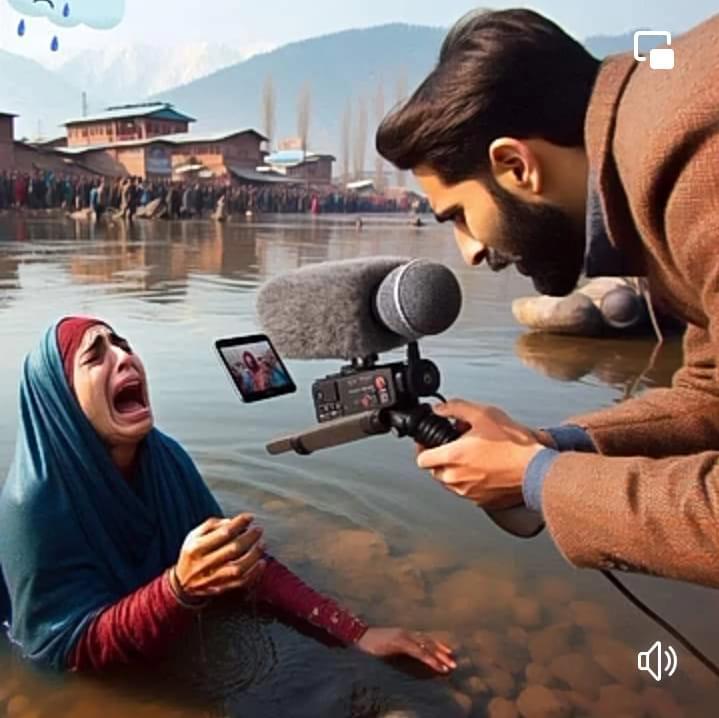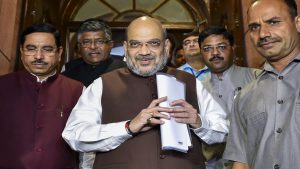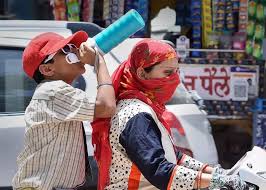
Exploiting Pain for Profit: How Social Media Content Creators Exploit Kashmir’s Tragedy
Human Suffering is Not Content: Demanding Accountability on Social Media
By: Javid Amin
In today’s digital age, social media has become a double-edged sword. On one hand, it allows for instant communication and the rapid spread of information; on the other hand, it has given rise to a disturbing trend: the exploitation of human suffering for clicks, views, and followers. Nowhere is this more evident than in the conflict-ridden region of Kashmir, where the stories of grief and tragedy serve as both news and entertainment for social media content creators (CCs). These individuals, often mistaken for journalists, exploit the raw pain of mourning families with zero accountability, escaping backlash by simply deleting their posts or issuing hollow apologies.
The Heartbreaking Scene: Exploiting Grief for Content
In one particularly heart-wrenching example, a Facebook page admin posing as a journalist intrudes on a grieving family. “May I be sacrificed for you; may I be sacrificed for your name,” utters a mother as the so-called journalist attaches a microphone to her shawl. Beside her, another mourner, the lady’s sister, tries to adjust her hijab while sobbing uncontrollably. The mother, pale and breathless from grief, struggles to answer invasive questions about her deceased son.
“He was seven. He was nine. He would have just turned nine,” the mother says in confusion. The CC continues to probe, asking, “How many children does your daughter have? What was her son’s name? How old was he?” The mother, suffocating from grief and the physical presence of the CC, struggles to breathe as the mic slips from her shawl.
Suddenly, a picture of her son, Showkat Ahmad, is displayed from the window. His mother’s attention shifts, and she screams, “Look at the hero, everyone. Look at his bright face!” This video, filmed just hours after a boat capsized in the Jhelum River, quickly went viral. Shared on April 16, it amassed over 11,000 views on YouTube and 178,000 views on Instagram, featuring a sensationalized soundtrack.
Hours before posting this video, the same Facebook page conducted a live broadcast showing people sitting on the riverbank, awaiting the retrieval of bodies. Misleadingly captioned “26 people died,” this 24-minute live stream garnered 15,000 views on Facebook, spreading misinformation to attract viewers.
The Invasion of Privacy: A Mother’s Agony on Display
“He was born after five daughters. I shredded my feet walking barefoot to shrines, from Makdoom Sahib to Sonwar, telling those who asked about my slippers that they had broken,” recounts Showkat’s mother, clutching a framed photo of her son. Showkat, a 40-year-old laborer, and his nine-year-old son Haziq were among the nine people who went missing in the Jhelum on April 16.
As the grieving mother moves with difficulty to show family pictures, the CCs follow her into her home, filming her every move. Oblivious to their intrusion, she continues to murmur, at times losing composure and screaming, beating her head with her hands. Other women gather to comfort her, but the CCs remain indifferent, more focused on capturing content than showing empathy.
The widow then pulls out a phone and dials Showkat’s number. The CC, showing no sensitivity to her anguish, asks, “Did his son drown too?” A background voice answers, “No, he did not,” sparing the mother further torment. “Is he alive then?” the CC persists. Showkat’s mother, devastated and confused, places the phone to the CC’s ear, shouting, “Showkat sahib, where are you? It is getting late, my beloved. Where are you?” Despite attempts to convince her that Showkat is alive, she remains inconsolable, questioning if her son felt suffocated in the waters.
On April 27, locals found the body of Showkat’s nine-year-old son, while Showkat himself remained missing.
The Perils of Sensationalism: A Growing Epidemic
The video, capturing these disturbing scenes, was posted at 7:22 pm on April 16 and reached an audience of 1.6 million on Facebook, 300,000 on YouTube, and 162,000 views on Instagram. It included a disclaimer stating that Showkat’s mother had turned ‘mad’ from the news of the drowning. This sensationalism and lack of sensitivity highlight a broader issue: the growing culture of exploiting human suffering for social media content.
Journalism in Kashmir has evolved significantly, from the publication of the first weekly newspaper, Tohfa-e-Kashmir, to the establishment of Radio Kashmir and the launch of DD Kashir. However, the advent of social media has transformed journalism, altering the nature of human relationships and interactions. The rise of Facebook content creation in Kashmir has become an epidemic, where commoners mistake CCs for journalists.
The Dark Side of Social Media Journalism
In the name of bridging communication gaps and reporting, these self-proclaimed journalists have turned social media into a platform for exploitation. They intrude on the lives of those in distress, extracting sensitive personal details and broadcasting them for public consumption. This commodification of human emotions is not new; from buying tickets to executions in the Middle Ages to now consuming content showcasing people grieving over their loved ones, society needs to rethink its choices.
With an internet connection, a microphone, and a camera, anyone can become a self-proclaimed journalist. According to The Telecom Regulatory Authority of India (2019), mobile internet usage for social media networking in Kashmir is a decade-old practice, with over four million internet users. While some are becoming aware of media literacy and social media hygiene, many remain unaware. These individuals, already weakened by their suffering, are thrust into the spotlight, divulging personal details they would otherwise keep private.
In some cases, people begin to see CCs as messiahs, as seen in the Srinagar boat tragedy when a mourner begged a CC to bring his son back, a gesture of submission. For CCs, these intense moments serve as fodder for their pages or live streams, consumed by strangers. Their cameras spare no one, recording everything from bereaved families to private homes, and even making intimate family matters public. These incidents are left for strangers to openly debate, discuss, and comment upon, wreaking havoc on the families involved.
The Human Cost: Real Stories, Real Pain
The exploitation of human suffering for social media content has real, devastating consequences. Showkat’s mother is just one of many who have had their most painful moments broadcast for the world to see. Her story, shared without consent and with little regard for her dignity, is a stark reminder of the human cost of this growing trend.
The Impact on Mental Health
The psychological impact on those whose grief is exploited cannot be overstated. Being thrust into the public eye during a time of intense personal tragedy can exacerbate feelings of vulnerability and helplessness. The invasive questioning and constant filming can lead to increased anxiety, depression, and a sense of violation. For many, the presence of CCs during their darkest moments adds a layer of trauma, making the grieving process even more challenging.
Community Response
While some community members may initially see CCs as helpful, bringing attention to their plight, the long-term effects often paint a different picture. The spread of misinformation and sensationalized content can lead to distrust and resentment. Communities may feel exploited and betrayed by those they initially believed were there to help. This erosion of trust can have lasting implications, making it harder for legitimate journalists and aid workers to engage with these communities in the future.
Legal and Ethical Considerations
The actions of CCs raise significant legal and ethical questions. The lack of consent, the spread of misinformation, and the exploitation of personal tragedy for profit all point to a need for greater regulation and accountability. In many regions, including Kashmir, the legal framework surrounding social media journalism is still evolving. There is an urgent need for clearer guidelines and stronger enforcement to protect individuals from exploitation and ensure that content creators adhere to ethical standards.
Moving Forward: Striking a Balance
Addressing the issue of social media exploitation requires a multifaceted approach. Here are some key strategies that can help strike a balance between the freedom of information and the protection of individual dignity.
Media Literacy and Education
One of the most effective ways to combat the negative impact of social media journalism is through media literacy and education. By teaching people how to critically evaluate the content they consume and produce, we can foster a more informed and responsible online community. Educational programs should focus on the importance of consent, the ethical implications of content creation, and the need for accuracy and sensitivity in reporting.
Strengthening Regulations and Accountability
Governments and regulatory bodies need to establish and enforce stricter guidelines for social media content creation. This includes requiring consent for filming and sharing personal stories, ensuring accuracy in reporting, and holding content creators accountable for the harm they cause. Social media platforms also have a role to play in enforcing these guidelines and removing harmful content promptly.
Promoting Ethical Journalism
Legitimate journalists and news organizations must continue to uphold high ethical standards and distinguish themselves from CCs. This involves rigorous fact-checking, obtaining consent, and reporting with sensitivity and respect for those involved. By setting a positive example, professional journalists can help restore public trust in the media and provide a counterbalance to the sensationalism of CCs.
Supporting Affected Communities
Communities affected by social media exploitation need support to cope with the emotional and psychological impact. This can include providing access to mental health services, legal assistance, and platforms to share their experiences and hold CCs accountable. Community organizations and advocacy groups can play a crucial role in offering this support and raising awareness about the issue.
Bottom-Line: A Call for Compassion and Responsibility
The exploitation of human suffering for social media content is a deeply troubling trend that demands urgent attention. In Kashmir, where stories of grief and tragedy are all too common, the actions of CCs add an additional layer of pain and exploitation to already vulnerable communities. By promoting media literacy, strengthening regulations, upholding ethical journalism standards, and supporting affected communities, we can begin to address this issue and protect individuals from further harm.
Ultimately, it is up to all of us—as consumers, creators, and regulators—to ensure that social media is used responsibly and compassionately. We must remember that behind every story of tragedy is a human being deserving of dignity and respect. Let us strive to create a digital world where empathy and accountability guide our actions, and where the voices of the grieving are heard with the care and sensitivity they deserve.
More Stories
Eid Shopping Slump in Kashmir: Online Retail and Recessionary Woes Cast a Shadow
Shop Local This Eid: Celebrate Community and Support Kashmiri Businesses By: Javid Amin Srinagar: The vibrant bazaars of Kashmir, usually...
Faith Finds Refuge: Tens of Thousands Flock to Kashmir’s Sacred Grove
A Tapestry of Faith: Kashmiri Nomads Flock to Baba Nagri Shrine Baba Nagri: Deep within the verdant embrace of a...
Kashmiri Pandits Return After 34 Years: Unity Blossoms in Murren
After 34 years, Kashmiri Pandits return to Murren for a reunion, welcomed by Muslim neighbors. A symbol of hope and...
Navigating the Gray Areas: Balancing Freedom and Responsibility in a Modern Family
Navigating Change in Kashmir: Equipping Our Youth for a Brighter Future By: Javid Amin In today’s rapidly evolving world, the...
Skipping School, Riding the Rails: A Disturbing Trend in Kashmir Education
A Shadow Over Paradise: The Rise of Student Bunking in Kashmir By: Javid Amin Kashmir, often referred to as "Paradise...
A Splash of Tradition and Sustainability: The Panzath Nag Spring Cleaning Festival
Kashmir's Panzath Nag Springs Get a Traditional Clean-Up Panzath, Kashmir - In the heart of Kashmir, nestled amidst the awe-inspiring...

